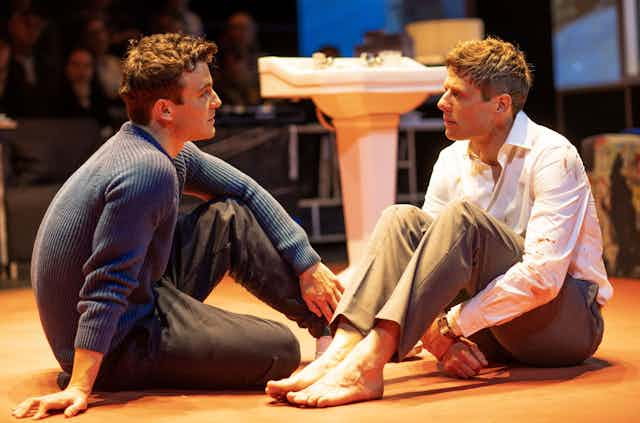The stage adaptation of Hanya Yanagihara’s 2015 novel A Little Life is well into its London run and has proved to be one of the most polarising theatre events of the year.
Reviewers have said the performance is “distressing”, “harrowing” “torture porn”. However, they have also said that the central performances are “a theatrical miracle” and “brilliant”. Such extreme contrasts, in my opinion, seem only to be expected for a novel that also garnered similar divided opinions.
Reviewers criticised its representation of trauma, its realism and its treatment of its gay characters. One particularly, scathing review by the critic Andrea Long Chu criticised what she saw as Yanagihara’s proclivity to “torture” her gay male characters.
However, there was also a lot of praise with the writer Garth Greenwell dubbing it “the great gay novel”.
Adapted for the stage by Ivo van Hove and Yanagihara herself, it was expected to be a very faithful adaptation of the beloved novel. Considering the difficulties and limitations of adapting a 700-page novel for the stage, it is fairly faithful. And therein lies the problem.
It’s not often that people complain about an adaptation being too faithful to its source material, but the play’s attempt to recreate characters’ written inner turmoil in a visual medium ultimately worsened the issues its most vehement critics had with it – those of authenticity and realism.
Representing the mind on stage
The novel’s expansively detailed creation of a mind unable to recover from extensive childhood trauma is what made it so affecting and disturbing to many readers. This detail relies heavily on Yanagihara’s incorporation of extended digressions into Jude’s psyche, excavating the harrowing memories and distressing thought patterns that plague him.
The play’s mode of introducing interiority into the performance hinged on character monologues, mostly from Jude, and the presence of Ana (Jude’s childhood social worker who tragically passed away early in his abuse recovery). Ana is rewritten as a kind of embodied memory or ghost figure who returns frequently to voice Jude’s thoughts or sometimes narrate his actions.

While it is difficult to try and show a character’s thoughts on stage without falling into extensive and potentially cheesy exposition, this choice felt somewhat condescending.
Similarly, a lot of the play’s sound design was immensely successful, but some choices felt odd. One such was the use of Arcade Fire’s My Body Is A Cage played at recurring intervals in moments where Jude’s physical and mental suffering was at its greatest.
While this worked at times, at others it felt like the audience was being spoon-fed Jude’s thoughts and anxieties, hammering home that his body limits him through song, rather than trusting the actors to portray this or the audience to pick it up from their stellar performances.
Trust your audience and trust your actors
The show should have trusted the acting because its quality is one of the few things reviewers agree on.
James Norton especially gives an astounding performance as Jude. His embodiment of adult and child Jude, sometimes side by side in the same scene and costume, is particularly astonishing. This collapsing of past and present in his performance was also one of the most successful aspects of the adaptation and was a powerful theatrical representation of trauma’s ability to endure across time.
In an New Yorker article criticising trauma storylines, Parul Sehgal makes an exception for A Little Life. She describes the book as an “exemplary novelistic incarnation” of “trauma theory”, so adapting the novel’s representation of the enduring nature of trauma was an important aspect to get right.
The trauma theory Sehgal speaks of is theorist Cathy Caruth’s notion of traumatic events as “unclaimed experience” that causes a “breach” in the mind’s experience of time, self and the world. Trauma, according to Caruth, is not a simple, healable wound and the book and play represent that agonisingly well.
There are, however, other aspects of the character’s psychology that the play just doesn’t get right. Although already long at three and a half hours, there is a lot of character history and mindset that the adaptation has chosen to represent with gimmicks.

Perhaps van Hove hoped to create a disorienting experience, a way of rendering the emotional onslaught of the novel by incorporating flashing lights, loud music, jarring tonal shifts and lots of fake blood. This does have its own undeniable effect, but it’s markedly different from the slow and extensive building of a life and psyche irreparably changed by trauma.
Instead, the audience watches a life in fast forward as the story jumps back and forth the timeline at breakneck speed. It’s whiplash-inducing to see all these things, many of which are heartbreaking and horrible, happening to a person without understanding or seeing how they process or comprehend them. We see little of why Jude behaves and thinks in certain ways outside of the simplified and linear conclusion of “childhood trauma equals haunted adult”.
The novel is more than the reductive “trauma porn” label it is often given. A Little Life illustrates how the traditional markers of success and happiness in contemporary neoliberal America – family, wealth, prestigious careers – are unable to help people heal from complex trauma, despite what we are sold.
Instead of this more nuanced take on contemporary culture, the play flattens and simplifies this message into the oft-repeated adage: be kind to everyone because you don’t know what they are going through. It’s a nice sentiment but ultimately lacks the critical heft of Yanagihara’s novel.

